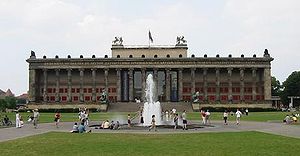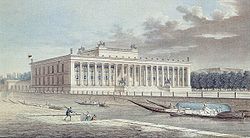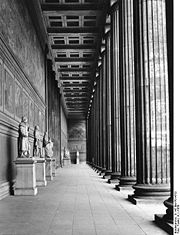
Altes Museum
Encyclopedia

Museum Island
Museum Island is the name of the northern half of an island in the Spree river in the central Mitte district of Berlin, Germany, the site of the old city of Cölln...
in Berlin
Berlin
Berlin is the capital city of Germany and is one of the 16 states of Germany. With a population of 3.45 million people, Berlin is Germany's largest city. It is the second most populous city proper and the seventh most populous urban area in the European Union...
, Germany
Germany
Germany , officially the Federal Republic of Germany , is a federal parliamentary republic in Europe. The country consists of 16 states while the capital and largest city is Berlin. Germany covers an area of 357,021 km2 and has a largely temperate seasonal climate...
. Since restoration work in 1966, it houses the Antikensammlung
Antikensammlung Berlin
The Antikensammlung Berlin is one of the most important collections of classical art in the world, now held in the Altes Museum and Pergamon Museum in Berlin, Germany. It contains thousands of ancient archaeological artefacts from the ancient Greek, Roman, Etruscan and Cypriot civilizations...
(antique collection) of the Berlin State Museums
Berlin State Museums
The Berlin State Museums, in German Staatliche Museen zu Berlin, are a group of museums in Berlin, Germany overseen by the Prussian Cultural Heritage Foundation and funded by the German federal government in collaboration with Germany's federal states...
. The museum was built between 1823 and 1830 by the architect Karl Friedrich Schinkel
Karl Friedrich Schinkel
Karl Friedrich Schinkel was a Prussian architect, city planner, and painter who also designed furniture and stage sets. Schinkel was one of the most prominent architects of Germany and designed both neoclassical and neogothic buildings.-Biography:Schinkel was born in Neuruppin, Margraviate of...
in the neoclassical
Neoclassicism
Neoclassicism is the name given to Western movements in the decorative and visual arts, literature, theatre, music, and architecture that draw inspiration from the "classical" art and culture of Ancient Greece or Ancient Rome...
style to house the Prussian
Kingdom of Prussia
The Kingdom of Prussia was a German kingdom from 1701 to 1918. Until the defeat of Germany in World War I, it comprised almost two-thirds of the area of the German Empire...
royal family's art collection. The historic, protected building counts among the most distinguished in neoclassicism and is a high point of Schinkel's career. Until 1845, it was called the Königliches Museum (Royal Museum). Along with the other museums and historic buildings on Museum Island, the Altes Museum was designated an UNESCO
UNESCO
The United Nations Educational, Scientific and Cultural Organization is a specialized agency of the United Nations...
World Heritage Site
World Heritage Site
A UNESCO World Heritage Site is a place that is listed by the UNESCO as of special cultural or physical significance...
in 1999.
Planning and location
In the early nineteenth century, Germany's bourgeoisie had become increasingly self-aware and self-confident. This growing class began to embrace new ideas regarding the relationship between itself and art, and the concepts that art should be open to the public and that citizens should be able to have access to a comprehensive cultural education began to pervade society. King Friedrich Wilhelm III of Prussia was a strong proponent of this humboldtianAlexander von Humboldt
Friedrich Wilhelm Heinrich Alexander Freiherr von Humboldt was a German naturalist and explorer, and the younger brother of the Prussian minister, philosopher and linguist Wilhelm von Humboldt...
ideal for education and charged Karl Friedrich Schinkel with planning a public museum for the royal art collection.
Schinkel's plans for the Königliches Museum, as it was then known, were also influenced by drafts of the crown prince, later King Friedrich Wilhelm IV, who desired a building that was heavily influenced by antiquity. The crown prince even sent Schinkel a pencil sketch of a large hall adorned with a classical portico.
Schinkel's plans incorporated the Königliches Museum into an ensemble of buildings, which surround the Berliner Lustgarten (pleasure garden). The Stadtschloss in the south was a symbol of worldly power, the Zeughaus
Zeughaus
The Zeughaus of Berlin is the oldest structure on the Unter den Linden. It was built by the Brandenburg Elector Frederick III between 1695 and 1730 in the baroque style, to be used as an artillery arsenal...
in the west represented military might, and the Berliner Dom
Berliner Dom
Berlin Cathedral is the colloquial name for the Evangelical Oberpfarr- und Domkirche in Berlin, Germany...
in the east was the embodiment of divine authority. The museum to the north of the garden, which was to provide for the education of the people, stood as a symbol for science and art—and not least for their torchbearer: the self-aware bourgeoisie.

Baroque
The Baroque is a period and the style that used exaggerated motion and clear, easily interpreted detail to produce drama, tension, exuberance, and grandeur in sculpture, painting, literature, dance, and music...
cathedral), and he exercised considerable influence on Peter Joseph Lenné
Peter Joseph Lenné
Peter Joseph Lenné was a Prussian gardener and landscape architect from Bonn who worked in the German classicist style.-Childhood and development:...
's renovation of the Lustgarten, which coincided with the construction of the museum, resulting in a harmonized and integrated ensemble.
In 1841, King Friedrich Wilhelm IV announced in a royal decree, that the entire northern part of the Spree Island (known as Museum Island) "be transformed into a sanctuary for art and science." In 1845, the Königliches Museum was renamed the Altes Museum, the name it holds to this day.
Exterior

Stoa
Stoa in Ancient Greek architecture; covered walkways or porticos, commonly for public usage. Early stoae were open at the entrance with columns, usually of the Doric order, lining the side of the building; they created a safe, enveloping, protective atmosphere.Later examples were built as two...
in Athens
Athens
Athens , is the capital and largest city of Greece. Athens dominates the Attica region and is one of the world's oldest cities, as its recorded history spans around 3,400 years. Classical Athens was a powerful city-state...
as a model, borrowing heavily from Greek antiquity and classical architecture. The museum employs the Ionic order
Ionic order
The Ionic order forms one of the three orders or organizational systems of classical architecture, the other two canonic orders being the Doric and the Corinthian...
to articulate the 87 m (285 ft.) face of the building, which is the only part of the exterior with any visual sign of the Orders; the other three remaining facades are of brick and stone banding. Atop the eighteen Ionic columns, which support the portico, sit eighteen sandstone eagles. The dedication inscription, upon which the eagles are perched, reads:
FRIDERICVS GVILHELMVS III. STVDIO ANTIQVITATIS OMNIGENAE ET ARTIVM LIBERALIVM MVSEVM CONSTITVIT MDCCCXXVIII — Friedrich Wilhelm III founded this museum for the study of all forms of antiquities and of the liberal arts in 1828.
Schinkel's original plans called for the installation of two large statues of mounted knights, which would flank the entrance to the museum. In 1842, the statue "Kämpfende Amazone" ("Fighting Amazonian Woman") by August Kiss
August Kiss
August Karl Eduard Kiss was a German sculptor.Kiss studied at the Berlin Academy under Christian Rauch, Tieck and Schinkel...
was placed on the right side of the main staircase leading into the building. It displays with great expressivity the attempts of an Amazonian woman to ward off a panther's attack. The statue on the opposite side, "Löwenkämpfer" ("Lion-fighter"), was not added until 1861. The statue, which shows a lance-wielding man on horseback about to kill a lion, was completed by Albert Wolff after a draft by Christian Daniel Rauch
Christian Daniel Rauch
Christian Daniel Rauch was a German sculptor. He founded the Berlin school of sculpture, and was the foremost German sculptor of the 19th century.-Biography:Rauch was born at Arolsen in the Principality of Waldeck...
. Eventually, it was built with two basic objectives: to serve a didactic role and to enhance the layout of one of the city's most representative areas in front of the Royal Palace. Schinkel experimented with some ideas already current in France; for example. the museum's division into galleries around an oval hall and the large portico with colonnades- two options that he interprets in an innovative manner
The body of the two-story building is raised on a plinth, giving the building a greater stature as well as preventing the risk of damage to the artwork from moisture or flooding, for which the island was renowned.
The Spree
Spree
The Spree is a river that flows through the Saxony, Brandenburg and Berlin states of Germany, and in the Ústí nad Labem region of the Czech Republic...
river from which the island protrudes was actually reconfigured by the architect, in order to allow enough ground space for the museum to be built. Necessary roadway changes, bridge expansions, and canals were introduced around the same time as the Altes Museum construction. The original dome, which was an exact hemisphere modelled on the Roman Pantheon, underscored ecclesiastic dimensions of the museum as a temple of art. It was made invisible to the exterior observer because of the museum's proximity to the Berliner Dom, as the museum was not meant to compete with the cathedral's dome. To avoid that, the rotunda was disguised with a square cover, which is reset from the front of the building and clearly visible from the exterior of the museum.
Interior
After the broad staircase and Ionic columns, the portico leads through a bronze portal to a double staircase ending in an upper hall. The staircase and hall are separated by a colonnade providing a panorama of Berlin.The exhibition rooms of the museum are grouped around two inner courtyards; the center of the building is the two-story (23 m), skylit rotunda, which is surrounded by a gallery supported by twenty Corinthian columns. Like the Pantheon
Pantheon, Rome
The Pantheon ,Rarely Pantheum. This appears in Pliny's Natural History in describing this edifice: Agrippae Pantheum decoravit Diogenes Atheniensis; in columnis templi eius Caryatides probantur inter pauca operum, sicut in fastigio posita signa, sed propter altitudinem loci minus celebrata.from ,...
in Rome
Rome
Rome is the capital of Italy and the country's largest and most populated city and comune, with over 2.7 million residents in . The city is located in the central-western portion of the Italian Peninsula, on the Tiber River within the Lazio region of Italy.Rome's history spans two and a half...
, its interior surface is adorned with coffering (rectangular, sunken panels). A portion of the museum's statue collection is displayed between the rotunda's twenty columns. Originally, the 6.9 m (23 ft.) wide granite basin by Christian Gottlieb Cantian, which now rests in the Lustgarten directly in front of the museum, was to be installed directly under the rotunda's skylight, but it was judged too large to be moved into the museum. The rotunda was the only portion of the museum, which was reconstructed in its original form during the 1966 renovation of the Altes Museum.
From behind the entrance lobby rises a two-winged, grand stairway, which is at once inside and outside, enclosed only with columns. Schinkel illustrated his idea of the purpose of the building with decorative figures on the walls of the stairway: it should provide material for direct observation and instruction (illustrated by a father and son) but also be able to encourage further thought and discussion (illustrated by two men in conversation).
Schinkel's most important work as a painter was a cycle of frescoes for the lobby of the museum. This monumental series of paintings, which was included in the first plans for the building and executed from 1841 to ca. 1870, covered the entire length of the portico and the upper stairwell. The murals were destroyed in the Second World War; only two original drafts in Schinkel's hand remain (on display in the Kupferstichkabinett Berlin
Kupferstichkabinett Berlin
The Kupferstichkabinett, or Museum of Prints and Drawings, is a prints museum in Berlin, Germany. It is part of the Berlin State Museums, and is located in the Kulturforum on Potsdamer Platz...
). This nearly forgotten mural cycle counts among the most important frescoes of the 19th century. The images were of great symbolic importance for the museum, provideding a detailed representation of Schinkel's ideas regarding the function and purpose of the museum.
History
The royally appointed commission, which was responsible for the conception of the museum, decided to display only "high" art in the museum. This precluded the incorporation of ethnography, prehistory and the excavated treasures of the Near East; instead, these artifacts were primarily housed in Schloss Monbijou.With the completion of the Neues Museum
Neues Museum
The ' is a museum in Berlin, Germany, located to the north of the Altes Museum on Museum Island.It was built between 1843 and 1855 according to plans by Friedrich August Stüler, a student of Karl Friedrich Schinkel. The museum was closed at the beginning of World War II in 1939, and was heavily...
(New Museum) by Friedrich August Stüler
Friedrich August Stüler
Friedrich August Stüler was an influential Prussian architect and builder. His masterwork is the Neues Museum in Berlin, as well as the dome of the triumphal arch of the main portal of the Berliner Stadtschloss.-Life:...
in 1855, Museum Island began to take form. This was followed by the Nationalgalerie (now the Alte Nationalgalerie
Alte Nationalgalerie
The Alte Nationalgalerie in Berlin is a gallery showing a collection of Classical, Romantic, Biedermeier, Impressionist and early Modernist artwork, all of which belong to the Staatliche Museen zu Berlin. The museum is situated on Museum Island, a UNESCO-designated World Heritage Site.- Founding...
) by Johann Heinrich Strack (1876), the Kaiser-Friedrich-Museum (now the Bodemuseum) by Ernst von Ihne after plans by Stüler (1904), and the Pergamonmuseum by Alfred Messel
Alfred Messel
Alfred Messel was one of the most well-known German architects at the turning point to the 20th century, creating a new style for buildings which bridged the transition from historicism to modernism...
and Ludwig Hoffmann
Ludwig Hoffmann
Ludwig Hoffmann was a Hauptsturmführer in the Waffen SS during World War II. He was a recipient of the Knight's Cross of the Iron Cross, which was awarded to recognize extreme battlefield bravery or successful military leadership by Nazi Germany during World War II.-Early life:Ludwig Hoffmann was...
(1930). Thus Museum Island evolved into the institution it is today.
Julius Carl Raschdorff's 1894–1905 reconstruction of the Berliner Dom into a neo-Renaissance
Neo-Renaissance
Renaissance Revival is an all-encompassing designation that covers many 19th century architectural revival styles which were neither Grecian nor Gothic but which instead drew inspiration from a wide range of classicizing Italian modes...
cathedral (replacing the classical cathedral designed by Schinkel) severely disrupted the classical ensemble, especially since the new cathedral has significantly larger dimensions than its predecessor.
During National Socialism, the Altes Museum was used as the backdrop for propaganda, both in the museum itself and upon the parade grounds of the redesigned Lustgarten. Just before the end of Second World War, the museum was badly damaged when a tank truck exploded in front of the museum, and the frescoes designed by Schinkel and Peter Cornelius, which adorned the vestibule and the back wall of the portico, were largely lost.
Under General Director Ludwig Justi, the building was the first museum of Museum Island to undergo reconstruction and restoration, which was carried out from 1951 to 1966 by Hans Erich Bogatzky and Theodor Voissen. Following Schinkel's designs, the murals of the rotunda were restored in 1982. However, neither the ornate ceilings of the ground floor exhibition rooms nor the pairs of columns under the girders were reconstructed. The former connection to the Neues Museum has also not been rebuilt; instead, an underground passageway connecting all of the museums of Museum Island is planned as part of the Museumsinsel 2015 renovations.
The Antique Collection
The Altes Museum was originally constructed to house all of the city's collections of fine arts. However, since 1904, the museum has housed the Antikensammlung (Collection of Classical Antiquities). Since 1998 the Collection of Classical Antiquities has displayed its Greek collection, including the treasury, on the ground floor of the Altes Museum. Special exhibitions are displayed on the second floor of the museum.Further reading
- Michael S. Cullen, Tilmann von Stockhausen: Das Alte Museum. Berlin-Edition, Berlin 1998, ISBN 3-8148-0002-8.
- Wolf-Dieter Heilmeyer, Huberta Heres, Wolfgang Maßmann: Schinkels Pantheon. Die Statuen der Rotunde im Alten Museum. Von Zabern, Mainz 2004, ISBN 3-8053-3255-6.
- Andreas Scholl, Gertrud Platz-Horster (Hrsg.): Altes Museum. Pergamonmuseum. Antikensammlung Staatlichen Museen zu Berlin. 3., vollständig überarbeitete und erweiterte Auflage. Von Zabern, Mainz 2007, ISBN 978-3-8053-2449-6.
- Jörg Trempler: Das Wandbildprogramm von Karl Friedrich Schinkel, Altes Museum Berlin. Gebr. Mann, Berlin 2001, ISBN 3-7861-2333-0.
- Elsa van Wezel: Die Konzeptionen des Alten und Neuen Museums zu Berlin und das sich wandelnde historische Bewusstsein. Gebr. Mann, Berlin 2003, ISBN 3-7861-2443-4 (=Jahrbuch der Berlin Museen N.F. Bd. 43, 2001, Beiheft).
External links
- Altes Museum at the website of the Berlin State Museums.
- Altes Museum at GreatBuildings.com.
- Altes Museum at Archiseek.com. Altes Museum at museum-location.de.

